
Black Locust (Robinia pseudoacacia) is a spiny, scraggly tree that is found abundantly along the US East Coast. Very little is written about this tree from a magical or mythological perspective, although certainly, anyone who works wood or practices permaculture is aware of the more tangible benefits this tree provides. In today’s post, we explore this amazing tree and start building some more specific magical knowledge to incorporate this tree into local druidic or nature-spirituality practices.
My parents’ land in Western PA, land where I grew up, consisted primarily of old potato fields. We had two sets of tree lines where the farmers had let the trees grow; these lines were full of huge cherry and maple trees grew. In between those tree lines as the land sloped down the mountain were open areas populated with blackberry bushes, hawthorn, and black locusts–several acres of them. These locust trees, rising bare and spindly out of the earth, often looked like skeletons–they would usually wait to put their leaves on well after the rest of the trees had gone green in the spring. They would also be the first to drop their leaves, sometimes as early as mid-September, while the rest of the trees would wait till near Samhain. It was if they didn’t enjoy the light half of the year and preferred the darkness of winter. As younger trees, they have pretty amazing wicked thorns (thorns similar to blackberry or raspberry thorns, rather than hawthorn-style thorns). These are thorns that catch, snag, and hold fast.
I’ve always known these trees to be powerful magical allies with a particularly strong energy–and yet, almost nothing is ever written about them. Needless to say, growing up among the locusts has given me a unique perspective on these amazing trees and I recognize them for the magic they hold. This post is a part of my Sacred Trees in the Americas series, which is my long-running series where I focus on trees that are dominant along the Eastern US, including in Western PA, where I live. Previous trees in this series have included: Chestnut, Cherry, Juniper, Birch, Elder, Walnut, Eastern White Cedar, Hemlock, Sugar Maple, Hawthorn, Hickory, Beech, Ash, White Pine, and Oak.
Black Locust: Identification and Ecology

Black locust is a distinctive tree–it has compound leaves that are between 6-12″ long. Each compound leaf has pairs of leaflets that are oval in shape. The younger branches and stems often have two sharp thorns at the base as well as thorns going up the smaller branches. Larger branches often jut out in odd directions and grow at odd angles, giving the tree its distinctive appearance. As the trees mature, thick gray-brown bark with thick ridges grows. The wood itself is a brown-gray with distinctive rings and it is very dense and heavy.
The black locusts growing at my parents’ land were growing, in part, because it is a tree that helps regenerate damaged ecosystems. My parents’ home was built on what was once old potato fields. After decades of growing potatoes, the soil was nutrient-poor and full of rocks and clay. Not all trees thrive in such an ecosystem, and this is part of why the black locusts came. Black locusts are trees that regenerate damaged soils–as they fix nitrogen, they often can be an early part of ecological succession to help repair damaged soils and serve as a pioneering species in that regard.
Black Locust is not tolerant of shade, and thus, prefers to grow in areas with plenty of sun including old fields, disturbed sites, and wastelands. It prefers a limestone-rich soil but otherwise can adapt to many other soil conditions. It is an early species–as other species grow up and as ecological succession continues, it dies back and makes way for other species.
Black locusts are native to part of the Appalachian mountains and parts of Iowa, stretching from Western PA to the top of Alabama, but has been widely planted beyond that smallish range. Partially, it is planted because its wood is extremely useful as it is heavy, durable, strong, and rot-resistant. But partially, it is planted because of its a great regenerator of poor soils.
Apparently now in places in the US, it is considered an “invasive” species. But since many of you know my thoughts on that term, I find this label pretty unfortunate. As the link in the first sentence suggests, Black locust is a first aid tree–it is adaptable, deals well with disruption and disrupted soil, has a tolerance for pollution and industrial waste–sounds like a pretty darn badass first aid responder tree to me! It is unfortunate that so many responder plants get such a reputation.
Wood and Uses
A really nice history of the black locust tree at the Live Science website explains how Black Locust is the hardest of our timber woods here in North America, including describing evidence that the Native Americans living in the mountains may have exported black locust to the coastal areas and that black locust was thus a valuable trade item. This is likely because Black Locust can resist rot for up to 100 years, making it an amazing building material! Native Americans also made many of their bows from Black Locust due to its strength. As Eric Sloane discusses in a Reverence of wood, Black Locust was well known in colonial times. Philadelphia, as a planned city, had an important street named after the Black Locust. It was exported very early in colonialization, starting in 1640. In 1686, Captain William Fitzhugh of wrote that the locust as “as durable as most brick walls.” (p. 57, Plants of Colonial Days by Raymond Taylor). These early wood exports (like Black Locust and Sassafrass) were exported because of their usefulness and uniqueness–think about how much value a wood had to be loaded on a ship and sent back to the old world. Black locust was one of the early exports, which really shows its value for a range of applications.
And today, Black Locus is still an extremely useful wood, finding a niche in any projects that call for strength, density, and rot resistance. Traditionally, it has been used for everything from houses to railroad ties and telephone poles to tool handles and mine props. It is very useful to line garden beds because it almost never rots. Because it is rot-resistant, it is also used for fence posting and building projects. As Eric Sloane discusses, it was also a frequent material in living hedges and fencing material due to its thorns.

Another historical fact shared from the Live Science article–it is likely that Black locust pins, holding the American Ships together, helped win the war of 1812. These pins, stronger than those oak pins of the British fleet, allowed the American ships to withstand more cannonball damage than the British ships, leading to victory. In this way, the strength of the Black Locust was directly pitted against the strength of the oak–and the Black Locust was the victor.
Edible and Incredible Black Locust Flowers
For about two weeks a year, the black locust radically transforms from its usual spindly and scraggy self to a carpet of beautiful and fragrant blossoms. These cascades of white flowers with little yellow centers–they look a lot like a pea (and locusts are related to the legume family, so this makes sense). These delightful sprigs of flowers can often be harvested with abandon, and you can harvest as much of them as you can reach!
Due to their abundance, I’ve made a lot of things from these flowers, but the best, by far is a black locust flower fritter. Pick flowers that are still yellow in the center (if they are going brown, it means they are past their prime). Make a simple fritter batter (1 cup flour, 1/2 cup milk, 1 tbsp sugar, 1 teaspoon baking powder, 2 eggs) and fry them for 3-4 minutes. I prefer frying them in coconut oil, which really enhances their flavor. The fritters are done when they are golden brown. Sprinkle with some cinnamon and powdered sugar for even more tasty goodness. I’ll also note that, in Nature’s Harvest, Sam Thayer writes that we don’t know how to treat flowers in a culinary sense since we don’t really have them widely used in our cooking in North America. But locust flowers can be treated like any other vegetable. He uses them in salads, vegetables in soups, green salads, fruit salads, stir-fries, and more.
I’ve also made pancakes from them (treating them like blueberries in pancakes) and also tried brewing them as a tea. Given the fragrant nature of these flowers, you’d expect the tea to be good, but really, it just isn’t. It has a bad taste, so I wouldn’t drink it. The pancakes are fun, however, and a nice seasonal treat! You can also eat the flowers fresh from the tree.
The beans are also edible, but they are so tiny, you have to be really dedicated to getting any kind of meal from them. I’ve tried and have collected a small handful of beans here and there, and when I throw them into a soup or something, they totally disappear. So probably not the best wild food out there, but the flowers more than makeup for it.
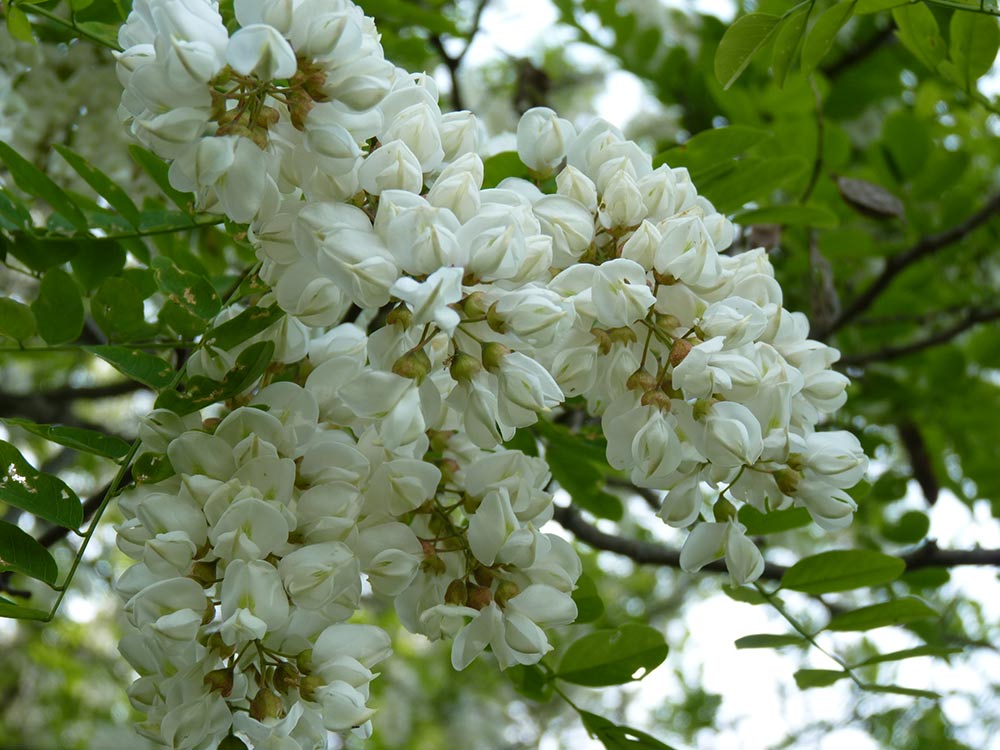
It’s important to note that beyond the flowers and the beans themselves, everything else on the black locust is toxic, including the bean pods and leaves. A poisonous glycoside called “robitin” is contained within the bark, leaves, roots, and wood, which is toxic to us as well as animals.
Magic and Herbal Qualities from the Western Tradition
This is where things start getting quite thin. Most of my normal reference books for herbalism (Wood, Culpepper, Grieve, Gerard, Gladstar) and magic (Greer, Yronwoode, etc) say literally nothing about black locust. It is a new world tree, and many of the older herbal books are based on old-world plants–new world plants and trees often get no notice (hence, my entire point of this series).
Books aside, a few herbalists list some information on their websites about Black Locust. For example, the Plants for a Future entry seems to confuse the black locust with the honey locust, talking about edible pulp (which is not a feature of the black locust). Henriette’s herbal suggests that the bark was used as a violent emetic (since it’s so toxic, yes, it would make you vomit violently!) It also lists the flowers as potentially anti-spasmodic, but I haven’t found that information in any other source.
That is, as far as I can tell, there is virtually nothing on the magical qualities of the Black Locust from a western perspective.
Native American Herbalism and Lore
Since this was a tree growing in the native range of North America, many tribes did have interactions with it, and I found a small amount of lore and stories surrounding it. Unfortunately, a lot of the tribes that would have interacted with this tree were forcefully removed and/or slaughtered–and much of their knowledge of this tree likely died with them. Here are two useful references:
From Sacred Formulas of the Cherokees (1891) by James Moody, Moody translates a discussion and a commentary on a particular kind of occult disease (or curse, perhaps). One of the ways this curse can manifest is by a maleficent person putting a sharpened stick of black locust into someone’s skin; if it is not removed the person may die.
In a second Cherokee story, the black locust is used to help a deer sharpen his teeth so that they aren’t as blunt (referring, likely, to the strength of the black locust wood).
Magic of the Black Locust
My story that opened this piece shared what I consider to be three of black locust’s most important features: some of the most strong, rot-resistant, and durable wood we have, regenerative qualities that help heal damaged ecosystems; and the skeletal nature of these trees’ growth cycle. To summarize my findings, I’d like to put forth the following magical and divination qualities for the black locust:
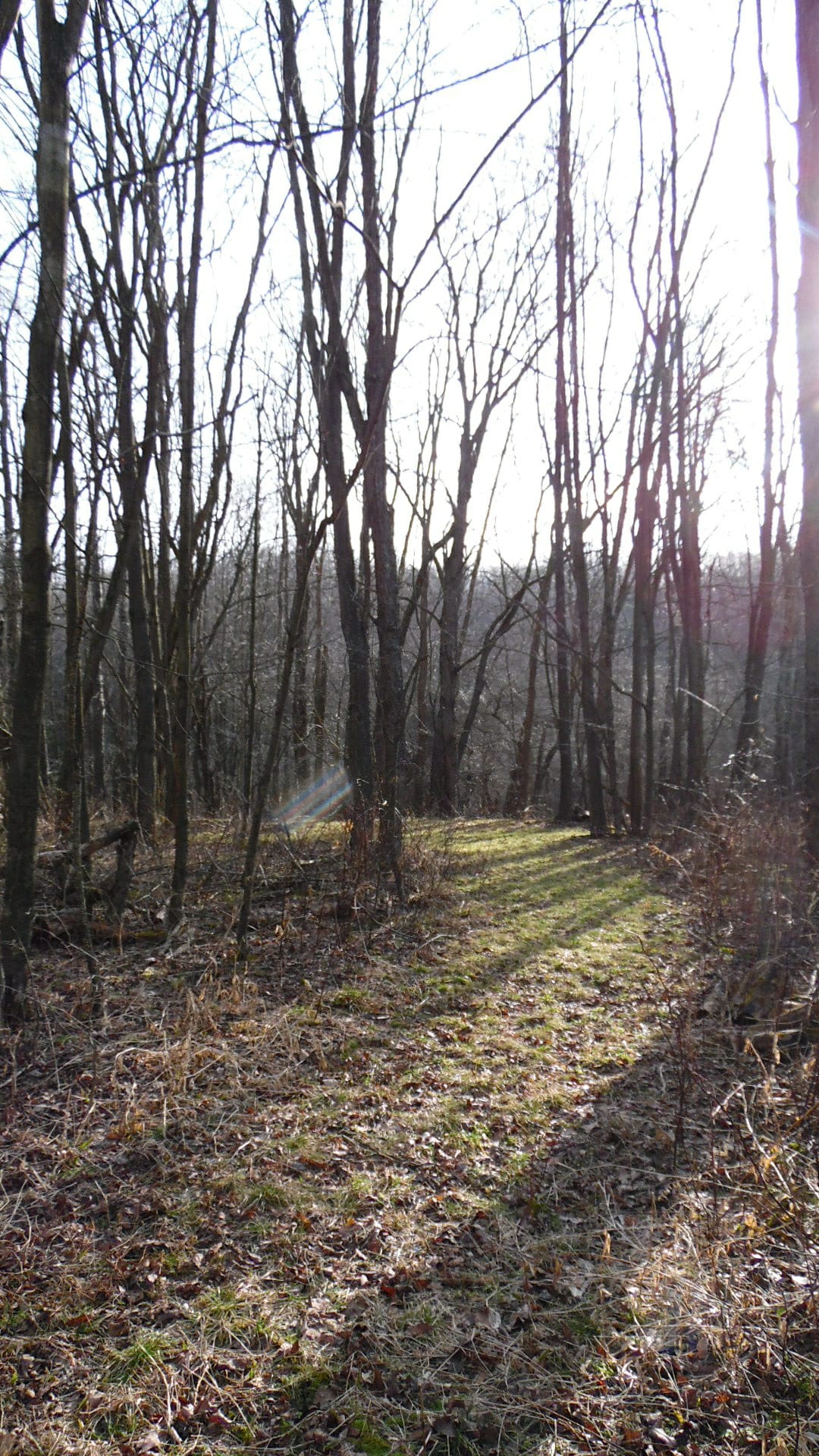
Ultimate strength and endurance. Black locust is beyond strong and endures beyond any other tree, particularly in death. It is rot-resistant, literally lasting 100 or more years, even when sunk into the earth. That beats most chemically treated woods, making it a tree that is ultimately connected to endurance, strength, and power.
Death and Life. If we look at the contrast of this tree ecologically, it offers us a rich interpretation of the interconnection between life and death. Here is a tree that looks like a skeleton, and spends more time being bare than covered in leaves. And yet, it offers landscape healing through nitrogen-fixing and regenerative qualities, working to quickly transform damaged landscapes.
Shadow and Underworld Work. Moving from the second point, I think this tree may help the living connect with the dead, and hence, can be a bridge to shadow work, underworld work, and work with the dying/decay energies of this time of year. The Skeletal nature of this tree, combined with its poison, and its short blooming time, really speaks to me of an underworld connection. This is a tree one can use to connect with the energies of the underworld, particularly at Samhain and the Winter Solstice, and use those energies for their own kind of shadow work.
What a tree indeed! Readers, do you have any additional information or stories on Black Locust to share?
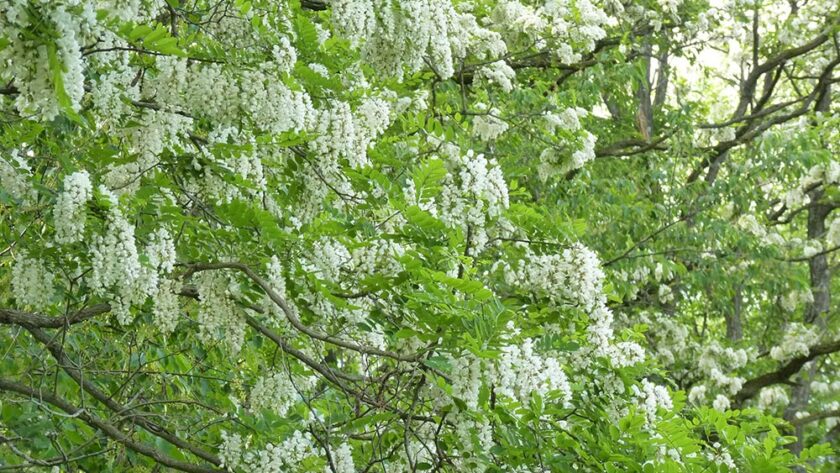
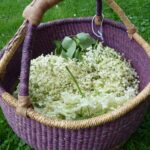
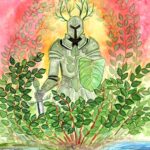

Reblogged this on Blue Dragon Journal.
Reblogged this on Paths I Walk.
We love the magic of black locust! Along with the attributes you mention, you can coppice it for firewood (very high btu’s) and it grows back quickly with lots of new shoots. It is also an excellent flower for native bees and honeybees. It is my favorite for walking sticks. Great blog!
I didn’t know it coppiced well! Thank you for that info :). I have had black locust honey–which is an amazing treat! 🙂
[…] via Sacred Tree Profile: Black Locust’s Medicine, Magic, Mythology and Meanings — The Druid’s … […]
Reblogged this on Good Witches Homestead.
I have a set of a locust seeds (minus the pod) that I call my “Ancestor Seeds.” I am uncertain of what type of locust tree they came from, but I have had them for many years. I keep them in a medicine bag. I feel like they help connect me to my ancestral guides. Someday they will be used inside a rattle that I will make myself. Have you explored rattles as a shamanic tool?
Thank you so much for this insightful post! I love your tree series. 🙂
How big are they? I would guess honey locust or kentucky coffee tree if they are large. Black locust seeds are tiny, about double the size of a large pin head. ‘
Yes, I use rattles frequently as a spiritual tool for journey work :). Blessings!
A black locust started growing in my yard out of nowhere so I researched the tree and came upon your blog. I live in Salem, MA across the street from where the witch hangings happened. My neighbor told me my tree must be an ancestor of those trees! I have always felt like my backyard was a spiritual portal.
That’s amazing! Thank you for sharing <3
I have a Black Locust in my back yard (BC Can.) and recently a message came to me about the tree in my yard and my senses went off. Thanks for compiling this! My one critique would be that it would be so neat of you to maybe try a little harder to get in touch with the First Nations healers to see what they have to say. I’m sure it would be challenging and take some digging, uncomfortable cold calls but think of what you (we) could learn from them. Their connection to the creator and the earth medicine is the same as the pagans. Anyways just a friendly though because that sounds like an incredible learning adventure and I’d live to learn what they have to pass along.
Hi Caitlin,
I have several Native American friends but none with extensive plant knowledge. I have studied some books written by native authors and have taken classes when they were available. :). Thanks for your comment!
I have always associated myself with the puck,Robyn, who, according to Kipling, used the magical phrase” by Oak,Ash&Thorn”. I have a bundle of the same hanging above my home’s entrance. I used local trees but have thought since that the Hawthorn which I planted here could actually be replaced with the native (south-east PA) black locust.As a child I helped Dad cut, cure and plant many a locust fence post to encompass the sheep pastures. The sheep, the fences and Dad are all long gone but the locust posts remain!
Hi Robby,
Thanks for sharing! Both Hawthorn and Black Locust are native to PA :). I love the story about your locust fence posts! Such a great tree.
https://thepuckrobyn.wordpress.com/2020/07/23/40/
After reading “The Green Witch” by Arin Murphy-Hiscock I began to learn more about the trees in my yard in SW PA. She doesn’t mention locust so I really appreciated your well-written and informative article. I’m wondering if the locust would make a good wand.
I’m also in Southwestern PA. We have several species of locust here, notably Kentucky Coffee Tree, Black Locust, and Honey Locust. All great trees to get to know :).
[…] Fitzhugh wrote that Black Locust wood is “as durable as most brick walls”. Black Locust was one of the very first export materials, which shows evidence of its value and range of applications. After all, Black Locust wood contains […]
I appreciate all the love you show this tree in your post. I am also a black locust lover. For all the reasons you mentioned we have included it in our plantings on our farm. I have found it to be the most resilient, tough, drought tolerant species that I grow. One thing I would like to chime in : you are right that Black Locusts leaves do contain a toxin, But in fact animals do eat it, and relish the The leaves at that. And not just domestic animals- deer will happily strip the lower leaves off . They are highly nutritious, comparable to alfalfa. It is only toxic if eaten in too high of quantities. Domestic Animals Should have plenty of other options grazing when black locust leaves are present. We practice management intensive grazing, and animals are never left to overgraze or overeat any one thing.
Hi Seth! Thanks so much for reading and your comments! And Thanks for the info on the toxin in the leaves. My understanding is that its in the leaves and the bark, but not in the seeds or flowers. But if it is only a small amount in the leaves, it could be great for grazing!
I wish I could send a photo of my tree which had to come down because of large limbs breaking off onto my street corner lot; obviously it was well past a century old. My house was built on the site of an old pasture. The tree was beautiful all year round but I loved it when it bloomed in the Spring.
Hi Dixie, it sounds like a lovely tree. Were you able to save any of the wood? I like to do something special with wood from a special tree :).
I have a black locust in my back yard here in NWPA. We moved into this home just over 2 years ago— it was a very long-term rental property with a huge back yard but no one has cared for the plants and landscaping in a very long time. I’ve made it my priority to put love back into this property. When we first moved in, it was winter and I honestly thought the black locust was a “random” dead tree! Imagine my surprise when I saw it in full bloom. I’m using this year to clear out the overgrown patch that it sits in and can’t wait for it to receive loving and caring vibes. Hopefully it will allow me to connect with it more meaningfully. Thanks for the great article!
Hi Laura,
Yeah! The black locusts have such a skeletal appearance…first to lose leaves and last to have them on the spring. And then there’s this two week period where they are in bloom! I love them so much. Where in NW PA are you? I’m near Indiana, PA, so also in Western PA :).
I was super curious about your location because I also followed this by reading about tulip poplars (we have a very large one in our front yard and I’m so excited to now know more about it) and then rhododendrons – I saw you mentioned driving on 422! I grew up near Grove City but live in Erie now 🙂
Haha, that’s great! Small world! I actually just recently drove through Grove City! 🙂
A new habit recently gifted me some accidentally fallen branches from a purple robe locust tree, and yours is the only article on the internet about locust spiritual qualities. Everything I read strikes true in my center. I deeply appreciate the time and effort you put into it! Gives me a fabulous jumping off point. I did make a flower essence remedy with the blossoms just past their peak, since I wanted to save some of the e magic before they withered completely. I stuck the branches in a giant jar of water on the porch, I wonder if they will root?
Is the purple robe locust simply a differently colored blossom, or an entirely new kind of magic? I always associate purple with royalty, and the 6th chakra, which is where I was primarily born and choose to live at most times. As an Aquarius, symbolism is deeply important. If you have any further insights into the purple robe, my curiosity knows no bounds and you are the first to open the conversation! Many thanks, neighbor 🥰🥰🥰
Hi Sarah!
The purple robe locust is still robinia pseudoacacia, which is also a black locust. I would think that most of it fits, but the purple flowers and the fact that this tree is considered an ornamental does give it maybe some additional elements. I like the direction you are thinking with its connection to the third eye. I had some of these where I lived in MI, but I don’t here in PA (I’ve never seen this variety in PA) so I can’t work with this tree directly to sort that out. But, it sounds like you can, so I’d suggest doing so! See what your insights in working with the Purple Robe are!
My property is in west central Missouri and it is FILLED with both black locusts and honey locusts. My father told me of it being used for fence posts here and how it was great fuel for the wood burner.
I appreciate you looking into the spiritual aspects of the tree, as I am drawn to make a wand from a branch. I really identify the strength and resilience correspondence of it.
Incidentally, the thorns all along the branches can grow to 4 inches long here and I’ve heard the cured thorns being used in place of nails during pioneering days. I know that they’re capable of puncturing tractor tires.
Thank you.
You are welcome, Jill! What a blessing to have so many wonderful black locust and honey locust trees :). Blessings to you!